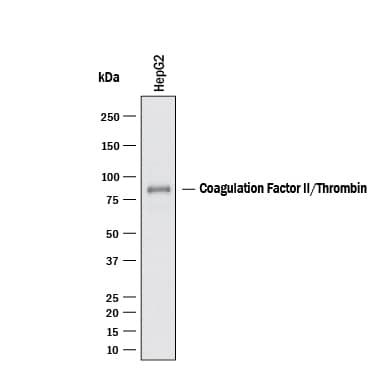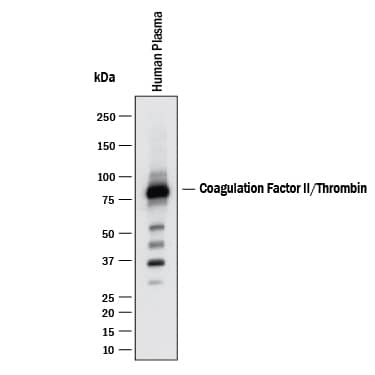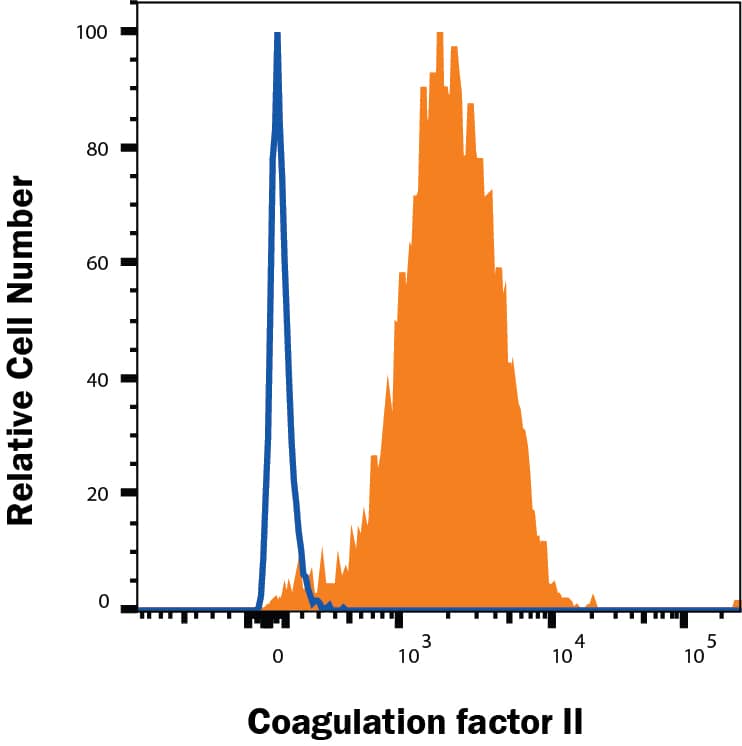Human Coagulation Factor II/Thrombin Antibody
R&D Systems, part of Bio-Techne | Catalog # AF1148


Key Product Details
Species Reactivity
Validated:
Cited:
Applications
Validated:
Cited:
Label
Antibody Source
Product Specifications
Immunogen
Specificity
Clonality
Host
Isotype
Scientific Data Images for Human Coagulation Factor II/Thrombin Antibody
Detection of Human Coagulation Factor II/Thrombin by Western Blot.
Western blot shows lysates of HepG2 human hepatocellular carcinoma cell line. PVDF membrane was probed with 0.1 µg/mL of Goat Anti-Human Coagulation Factor II/Thrombin Antigen Affinity-purified Polyclonal Antibody (Catalog # AF1148) followed by HRP-conjugated Anti-Goat IgG Secondary Antibody (Catalog # HAF017). A specific band was detected for Coagulation Factor II/Thrombin at approximately 75 kDa (as indicated). This experiment was conducted under reducing conditions and using Western Blot Buffer Group 1.Detection of Human Coagulation Factor II/Thrombin by Western Blot.
Western blot shows human plasma. PVDF membrane was probed with 0.1 µg/mL of Goat Anti-Human Coagulation Factor II/Thrombin Antigen Affinity-purified Polyclonal Antibody (Catalog # AF1148) followed by HRP-conjugated Anti-Goat IgG Secondary Antibody (HAF017). A specific band was detected for Coagulation Factor II/Thrombin at approximately 75 kDa (as indicated). This experiment was conducted under reducing conditions and using Western Blot Buffer Group 1.Detection of Human Factor II/Thrombin in HepG2 Human Cell Line by Flow Cytometry.
HepG2 human hepatocellular carcinoma cell line was stained with Goat Anti-Human Factor II/Thrombin Polyclonal Antibody (Catalog # AF1148, filled histogram) or control antibody (AB-108-C, open histogram), followed by Allophycocyanin-conjugated Anti-Goat IgG Secondary Antibody (F0108). Staining was performed using our Staining Membrane-Associated Proteins protocol.Applications for Human Coagulation Factor II/Thrombin Antibody
CyTOF-ready
Flow Cytometry
Sample: Human peripheral blood monocytes and HepG2 human hepatocellular carcinoma cell line
Simple Western
Sample: Human liver tissue
Western Blot
Sample: HepG2 human hepatocellular carcinoma cell line and Human Plasma
Formulation, Preparation, and Storage
Purification
Reconstitution
Formulation
Shipping
Stability & Storage
- 12 months from date of receipt, -20 to -70 °C as supplied.
- 1 month, 2 to 8 °C under sterile conditions after reconstitution.
- 6 months, -20 to -70 °C under sterile conditions after reconstitution.
Background: Coagulation Factor II/Thrombin
Coagulation Factor II, commonly known as thrombin, is an essential component of the coagulation cascade in which it converts fibrinogen to fibrin, activates factors V, VII, VIII, XIII and forms complexes with protein C and thrombomodulin (1). It also activates platelets and regulates the behavior of additional cells through protease‑activated receptors (PARs) (2). It may have either protective or deleterious functions, depending on the level and location (3). Its activity is regulated by endogenous inhibitors such as anti-thrombin III (serpin C1) or heparin cofactor II (serpin D1). A plasma serine protease, thrombin is synthesized in the liver as a 622 amino acid precursor with a 24 amino acid signal peptide. Cleavage by itself or by similar enzymes converts the proenzyme to three forms designated as alpha-, beta- and gamma-thrombin. Composed of a disulfide bond-linked dimer of the light chain (A) (residues 328‑363) and the heavy chain (B) (residues 364‑622), alpha-thrombin displays the diverse functions as described above. In comparison, the further processed B chains of beta- and gamma-thrombin have no known physiological function, but retain most of the activity towards small synthetic substrates (4).
References
- Degen, S.J. and E.W. Davie (1987) Biochemistry 26:6165.
- Coughlin, S.R. (2000) Nature 407:258.
- Xi, G. et al. (2003) J. Neurochem. 84:3.
- Rydel, T.J. et al. (1994) J. Biol. Chem. 269:22000.
Alternate Names
Gene Symbol
Additional Coagulation Factor II/Thrombin Products
Product Documents for Human Coagulation Factor II/Thrombin Antibody
Product Specific Notices for Human Coagulation Factor II/Thrombin Antibody
For research use only



